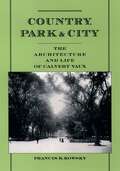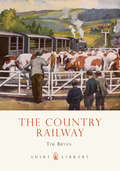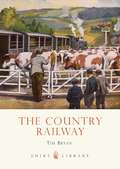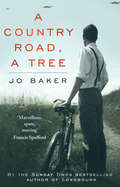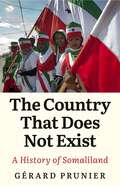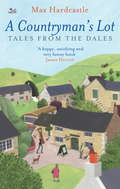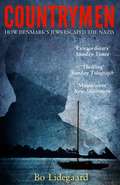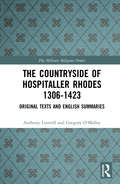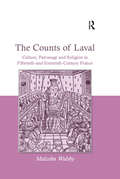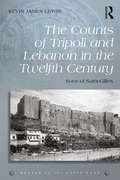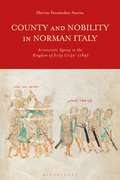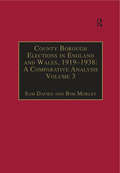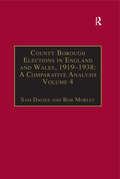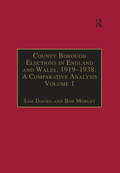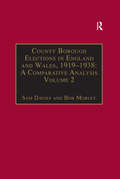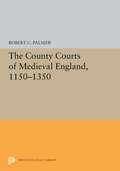- Table View
- List View
Country, Park & City: The Architecture and Life of Calvert Vaux
by Francis R. KowskyAfter beginning his career as an architect in London, Calvert Vaux (1824-1895) came to the Hudson River valley in 1850 at the invitation of Andrew Jackson Downing, the reform-minded writer on houses and gardens. As Downing's partner, and after Downing's death in 1852, Vaux designed country and suburban dwellings that were remarkable for their well-conceived plans and their sensitive rapport with nature. By 1857, the year he published his book Villas and Cottages, Vaux had moved to New York City. There he asked Frederick Law Olmsted to join him in preparing a design for Central Park. He spent the next 38 years defending and refining their vision of Central Park as a work of art. After the Civil War, he and Olmsted led the nascent American park movement with their designs for parks and parkways in Brooklyn, Buffalo, and many other American cities. Apart from undertakings with Olmsted, Vaux cultivated a distinguished architectural practice. Among his clients were the artist Frederic Church, whose dream house, Olana, he helped create; and the reform politician Samuel Tilden, whose residence on New York's Gramercy Park remains one of the country's outstanding Victorian buildings. A pioneering advocate for apartment houses in American cities, Vaux designed buildings that mirrored the advance of urbanization in America, including early model housing for the poor. He planned the original portions of the Metropolitan Museum of Art and the American Museum of Natural History and conceived a stunning proposal for a vast iron and glass building to house the Centennial Exhibition in Philadelphia. Especially notable are the many bridges and other charming structures that he designed for Central Park. Vaux considered the Park's Terrace, decorated by J. W. Mould, as his greatest achievement. An active participant in the cultural and intellectual life of New York, Vaux was an idealist who regarded himself as an artist and a professional. And while much has been written on Olmsted, comparatively little has been published about Vaux. The first in-depth account of Vaux's career, Country, Park, and City should be of great interest to historians of art, architecture, and urbanism, as well as preservationists and other readers interested in New York City's past and America's first parks.
The Country Railway (Shire Library #756)
by Tim BryanBritain's towns and cities were famously transformed in the nineteenth century by the coming of the railways, turning their fortunes around and giving urban dwellers new opportunities to travel across the country – yet the effect on the rural population was arguably far greater. Whilst some of the initial trunk lines were designed to link major cities, the network of smaller cross-country and branch lines that followed opened up large tracts of previously remote countryside, providing new markets for agricultural produce and ending the isolation of many rural communities, and such was the pace of development during the Railway Mania period that by the end of the nineteenth century there were few areas of country not served by train. This book tells the story of these railways from golden age to decline in the wake of nationalization and the Beeching Report in the mid-twentieth century – and indeed contemporary efforts to restore and preserve them.
The Country Railway (Shire Library)
by Tim BryanBritain's towns and cities were famously transformed in the nineteenth century by the coming of the railways, turning their fortunes around and giving urban dwellers new opportunities to travel across the country – yet the effect on the rural population was arguably far greater. Whilst some of the initial trunk lines were designed to link major cities, the network of smaller cross-country and branch lines that followed opened up large tracts of previously remote countryside, providing new markets for agricultural produce and ending the isolation of many rural communities, and such was the pace of development during the Railway Mania period that by the end of the nineteenth century there were few areas of country not served by train. This book tells the story of these railways from golden age to decline in the wake of nationalization and the Beeching Report in the mid-twentieth century – and indeed contemporary efforts to restore and preserve them.
A Country Road, A Tree
by Jo BakerBY THE SUNDAY TIMES BESTSELLING AUTHOR OF LONGBOURNSHORTLISTED FOR THE WALTER SCOTT PRIZE FOR HISTORICAL FICTION 2017SHORTLISTED FOR THE JAMES TAIT BLACK PRIZE 2017 'Skilful . . . daring . . . extraordinary' The Guardian'A fascinating fictional account of Samuel Beckett's wartime years' IAN RANKIN'Beautifully written, empathetic and unflinching, it is very, very good' Daily Mail'Marvellous, spare, moving' FRANCIS SPUFFORD'Insightful . . . beautifully paced . . . authentic’ The Irish TimesParis, 1939: The pavement rumbles with the footfall of Nazi soldiers marching along the Champs Elysees. A young writer, recently arrived from Ireland to make his mark, smokes one last cigarette with his lover before the city they know is torn apart. Soon, he will put is own life and those of his loved ones in mortal danger by joining the Resistance...Spies, artists, deprivation, danger and passion: this is a story of life at the edges of human experience, and of how one man came to translate it all into art.Sunday Express Book of the MonthPraise for Jo Baker's LONGBOURN:'Intoxicating' Guardian'Engrossing' Sunday Times'Audacious' New York Times
The Country That Does Not Exist: A History of Somaliland
by Gérard PrunierThe Somali people are fiercely nationalistic. Colonialism split them into five segments divided between four different powers. Thus decolonization and pan-Somalism became synonymous. In 1960 a partial reunification took place between British Somaliland and Somalia Italiana. Africa Confidential wrote at the time that the new Somali state would never be beset by tribal division but this discounted the existence of powerful clans within Somali society and the persistence of colonial administrative cultures. The collapse of parliamentary democracy in 1969 and the resulting army--and clanic--dictatorship that followed led to a civil war in the 'perfect' national state. It lasted fourteen years in the "British" North and is still raging today in the 'Italian' South. Somaliland "re-birthed" itself through an enormous solo effort but the viable nation so recreated within its former colonial borders was never internationally recognized and still struggles to exist economically and diplomatically. This book recounts an African success story where the peace so widely acclaimed by the international community has had no reward but its own lonely achievement.
The Country That Does Not Exist: A History of Somaliland
by Gérard PrunierThe Somali people are fiercely nationalistic. Colonialism split them into five segments divided between four different powers. Thus decolonization and pan-Somalism became synonymous. In 1960 a partial reunification took place between British Somaliland and Somalia Italiana. Africa Confidential wrote at the time that the new Somali state would never be beset by tribal division but this discounted the existence of powerful clans within Somali society and the persistence of colonial administrative cultures. The collapse of parliamentary democracy in 1969 and the resulting army--and clanic--dictatorship that followed led to a civil war in the 'perfect' national state. It lasted fourteen years in the "British" North and is still raging today in the 'Italian' South. Somaliland "re-birthed" itself through an enormous solo effort but the viable nation so recreated within its former colonial borders was never internationally recognized and still struggles to exist economically and diplomatically. This book recounts an African success story where the peace so widely acclaimed by the international community has had no reward but its own lonely achievement.
A Countryman's Lot: Tales From The Dales
by Max HardcastleMax and Vicky Hardcastle have a daydream . . .One day, they'll sell their cramped city-centre antiques shop and the overflowing upstairs flat and relocate to the beautiful Yorkshire Dales. If they could only find the perfect place to house both family and business, then that fantasy might become a reality. . . When a smallholding in a remote Dales village comes on the market, it seems like the answer to their prayers. Bullpen Farm might need 'some renovation', but it has an orchard, outbuildings and all the charm they've dreamt of. Before long, the Hardcastles find themselves the proud owners of a collection of ramshackle buildings and the newest members of a close-knit community which seems to have more than its fair share of eccentrics.From the antics of the antiques trade to the uproarious incidents of village life, it turns out that rural living isn't quite as tranquil as they'd imagined!'A happy, satisfying and very funny book' James Herriot
Countrymen: The Untold Story of How Denmark's Jews Escaped the Nazis
by Bo LidegaardThe rescue of the Danish Jews from Nazi persecution in October 1943 is a unique exception to the tragic history of the Holocaust. Over fourteen harrowing days, as they were helped, hidden and protected by ordinary people who spontaneously rushed to save their fellow citizens, an incredible 7,742 out of 8,200 Jewish refugees were smuggled out all along the coast - on ships, schooners, fishing boats, anything that floated - to Sweden. Now, for the first time, Bo Lidegaard brings together decades of research and new evidence, including unpublished diaries and documents of families forced to run for safety and of those who courageously came to their aid, to tell this story of ordinary glory, of simple courage and moral fortitude that shines out in the midst of the terrible history of the twentieth century and demonstrates how it was possible for a small and fragile democracy to stand against the Third Reich.
The Countryside Of Hospitaller Rhodes 1306-1423: Original Texts And English Summaries
by Anthony Luttrell Greg O'MalleyThe Countryside of Hospitaller Rhodes 1306–1423 explores the main themes of settlement, population and defence of the countryside of Rhodes from 1306 to 1423, approximately halfway through the period of Hospitaller rule. Based largely on the Hospital’s Rhodian archive, this book is the scientific presentation of 208 documents brought together with detailed English summaries to help readers understand the documents and their technical features. While the majority of research into this subject has previously been focused on the town of Rhodes, this book concentrates instead on the late-medieval countryside, providing a new angle from which to view this complex period. Through a corpus of Hospitaller texts, it presents many aspects of the Hospitaller Order’s history as well as exploring other crucial developments in the period, including both a discussion of Cristoforo Buondelmonti’s description of Rhodes, and a section dedicated to the sources used within this work. The Countryside of Hospitaller Rhodes provides an ideal for academics and postgraduates of the crusades.
The Countryside Of Hospitaller Rhodes 1306-1423: Original Texts And English Summaries
by Anthony Luttrell Greg O'MalleyThe Countryside of Hospitaller Rhodes 1306–1423 explores the main themes of settlement, population and defence of the countryside of Rhodes from 1306 to 1423, approximately halfway through the period of Hospitaller rule. Based largely on the Hospital’s Rhodian archive, this book is the scientific presentation of 208 documents brought together with detailed English summaries to help readers understand the documents and their technical features. While the majority of research into this subject has previously been focused on the town of Rhodes, this book concentrates instead on the late-medieval countryside, providing a new angle from which to view this complex period. Through a corpus of Hospitaller texts, it presents many aspects of the Hospitaller Order’s history as well as exploring other crucial developments in the period, including both a discussion of Cristoforo Buondelmonti’s description of Rhodes, and a section dedicated to the sources used within this work. The Countryside of Hospitaller Rhodes provides an ideal for academics and postgraduates of the crusades.
The Counts of Laval: Culture, Patronage and Religion in Fifteenth- and Sixteenth-Century France
by Malcolm WalsbyThe Lavals were one of the most important families in late medieval France, rising to a position of unsurpassed eminence by the mid sixteenth century. Yet, at the very point where they reached this position of unrivalled importance, all was put at risk by the dual challenges of dynastic failure and the Reformation. The vagaries of dynastic failure threatened their hard won success and these problems were compounded by the decision of crucial members of the family to support Protestantism in the middle of the century. By the end of the sixteenth century the fortunes of the family were in ruins and the brief eminence of Lavals in western France was over. This monograph offers a fresh look at several of the critical questions facing historians of late medieval and early modern France. It re-examines the clientage of a rising and enterprising family and explores the cultural patronage of a noble court. The book also provides a new insight into the nature of noble Protestantism, notably analysing the connections between nobles, patterns of family loyalty and religious conviction. Finally, it considers the events of wars of religion in western France from the perspective of a noble leadership that simultaneously played a vital role in sustaining the cause and did much to undermine it. This latter issue is examined in particular through the analysis of the relationship between the houses of Laval and Rohan, two Protestant families with shared loyalties but with rival dynastic ambitions. This study is based on a complete re-examination of the archive base in both Paris and the west of France and in English archives. For many centuries the destruction of the archives of the family of Laval during the French Revolution has prevented historians from undertaking a serious study of the family. Indeed, this book is the first monograph to be published on the Comtes de Laval since the manuscript volume written by Le Blanc de La Vignole in the seventeenth century. At the same time it engages with the historiography of both French and Anglo-Saxon historiographical traditions.
The Counts of Laval: Culture, Patronage and Religion in Fifteenth- and Sixteenth-Century France
by Malcolm WalsbyThe Lavals were one of the most important families in late medieval France, rising to a position of unsurpassed eminence by the mid sixteenth century. Yet, at the very point where they reached this position of unrivalled importance, all was put at risk by the dual challenges of dynastic failure and the Reformation. The vagaries of dynastic failure threatened their hard won success and these problems were compounded by the decision of crucial members of the family to support Protestantism in the middle of the century. By the end of the sixteenth century the fortunes of the family were in ruins and the brief eminence of Lavals in western France was over. This monograph offers a fresh look at several of the critical questions facing historians of late medieval and early modern France. It re-examines the clientage of a rising and enterprising family and explores the cultural patronage of a noble court. The book also provides a new insight into the nature of noble Protestantism, notably analysing the connections between nobles, patterns of family loyalty and religious conviction. Finally, it considers the events of wars of religion in western France from the perspective of a noble leadership that simultaneously played a vital role in sustaining the cause and did much to undermine it. This latter issue is examined in particular through the analysis of the relationship between the houses of Laval and Rohan, two Protestant families with shared loyalties but with rival dynastic ambitions. This study is based on a complete re-examination of the archive base in both Paris and the west of France and in English archives. For many centuries the destruction of the archives of the family of Laval during the French Revolution has prevented historians from undertaking a serious study of the family. Indeed, this book is the first monograph to be published on the Comtes de Laval since the manuscript volume written by Le Blanc de La Vignole in the seventeenth century. At the same time it engages with the historiography of both French and Anglo-Saxon historiographical traditions.
The Counts of Tripoli and Lebanon in the Twelfth Century: Sons of Saint-Gilles (Rulers of the Latin East)
by Kevin James LewisThe county of Tripoli in what is now North Lebanon is arguably the most neglected of the so-called ‘crusader states’ established in the Middle East at the beginning of the twelfth century. The present work is the first monograph on the county to be published in English, and the first in any western language since 1945. What little has been written on the subject previously has focused upon the European ancestry of the counts of Tripoli: a specifically Southern French heritage inherited from the famous crusader Raymond IV of Saint-Gilles. Kevin Lewis argues that past historians have at once exaggerated the political importance of the counts’ French descent and ignored the more compelling signs of its cultural impact, highlighting poetry composed by troubadours in Occitan at Tripoli’s court. For Lewis, however, even this belies a deeper understanding of the processes that shaped the county. What emerges is an intriguing portrait of the county in which its rulers struggled to exert their power over Lebanon in the face of this region’s insurmountable geographical forces and its sometimes bewildering, always beguiling diversity of religions, languages and cultures. The counts of Tripoli and contemporary Muslim onlookers certainly viewed the dynasty as sons of Saint-Gilles, but the county’s administration relied upon Arabic, its stability upon the mixed loyalties of its local inhabitants, and its very existence upon the rugged mountains that cradled it. This book challenges prevailing knowledge of this little-known crusader state and by extension the medieval Middle East as a whole. .
The Counts of Tripoli and Lebanon in the Twelfth Century: Sons of Saint-Gilles (Rulers of the Latin East)
by Kevin James LewisThe county of Tripoli in what is now North Lebanon is arguably the most neglected of the so-called ‘crusader states’ established in the Middle East at the beginning of the twelfth century. The present work is the first monograph on the county to be published in English, and the first in any western language since 1945. What little has been written on the subject previously has focused upon the European ancestry of the counts of Tripoli: a specifically Southern French heritage inherited from the famous crusader Raymond IV of Saint-Gilles. Kevin Lewis argues that past historians have at once exaggerated the political importance of the counts’ French descent and ignored the more compelling signs of its cultural impact, highlighting poetry composed by troubadours in Occitan at Tripoli’s court. For Lewis, however, even this belies a deeper understanding of the processes that shaped the county. What emerges is an intriguing portrait of the county in which its rulers struggled to exert their power over Lebanon in the face of this region’s insurmountable geographical forces and its sometimes bewildering, always beguiling diversity of religions, languages and cultures. The counts of Tripoli and contemporary Muslim onlookers certainly viewed the dynasty as sons of Saint-Gilles, but the county’s administration relied upon Arabic, its stability upon the mixed loyalties of its local inhabitants, and its very existence upon the rugged mountains that cradled it. This book challenges prevailing knowledge of this little-known crusader state and by extension the medieval Middle East as a whole. .
County and Nobility in Norman Italy: Aristocratic Agency in the Kingdom of Sicily, 1130-1189
by Hervin Fernández-AcevesWhilst historians often regard the Norman Kingdom of Sicily as centralised and administratively advanced, County and Nobility in Norman Italy counters this traditional interpretation; far from centralised and streamlined, this book reveals how the genesis and social structures of the kingdom were constantly fraught between the forces of royal power and local aristocracy authority. In doing so, Hervin Fernandez-Aceves sheds important new light on medieval Italy. This book is the result of thorough research conducted on the vast source material for the history of this fascinating 12th-century world. Starting with the activities of Norman counts and the configuration of the counties, it explores how social control operated in these nodes of regional authority, and argues that the Sicilian monarchy relied on the counties (and the counts' authority) to keep the realm united and exercise control.
County and Nobility in Norman Italy: Aristocratic Agency in the Kingdom of Sicily, 1130-1189
by Hervin Fernández-AcevesWhilst historians often regard the Norman Kingdom of Sicily as centralised and administratively advanced, County and Nobility in Norman Italy counters this traditional interpretation; far from centralised and streamlined, this book reveals how the genesis and social structures of the kingdom were constantly fraught between the forces of royal power and local aristocracy authority. In doing so, Hervin Fernandez-Aceves sheds important new light on medieval Italy. This book is the result of thorough research conducted on the vast source material for the history of this fascinating 12th-century world. Starting with the activities of Norman counts and the configuration of the counties, it explores how social control operated in these nodes of regional authority, and argues that the Sicilian monarchy relied on the counties (and the counts' authority) to keep the realm united and exercise control.
County Borough Elections in England and Wales, 1919–1938: Volume 3: Chester to East Ham (County Borough Elections in England and Wales, 1919-1938)
by Sam Davies Bob MorleyThese volumes provide an essential comprehensive work of reference for the annual municipal elections that took place each November in the 83 County Boroughs of England and Wales between 1919 and 1938. They also provide an extensive and detailed analysis of municipal politics in the same period, both in terms of the individual boroughs and of aggregate patterns of political behaviour. Being annual, these local election results give the clearest and most authoritative record of how political opinion changed between general elections, especially useful for research into the longer gaps such as 1924-29 and 1935-45, or crisis periods such as 1929-31. They also illuminate the impact of fringe parties such as the Communist Party and the British Union of Fascists, and also such questions as the role of women in politics, the significance of religious and ethnic differentiation and the connection between occupational and class divisions and party allegiance. Analysis at the ward level is particularly useful for socio-spatial studies. A major work of reference, County Borough Elections in England and Wales, 1919-1938 is indispensable for university libraries and local and national record offices. Each volume has approximately 700 pages.
County Borough Elections in England and Wales, 1919–1938: Volume 4: Exeter - Hull (County Borough Elections in England and Wales, 1919-1938)
by Sam Davies Bob MorleyThese volumes provide an essential comprehensive work of reference for the annual municipal elections that took place each November in the 83 County Boroughs of England and Wales between 1919 and 1938. They also provide an extensive and detailed analysis of municipal politics in the same period, both in terms of the individual boroughs and of aggregate patterns of political behaviour. Being annual, these local election results give the clearest and most authoritative record of how political opinion changed between general elections, especially useful for research into the longer gaps such as 1924-29 and 1935-45, or crisis periods such as 1929-31. They also illuminate the impact of fringe parties such as the Communist Party and the British Union of Fascists, and also such questions as the role of women in politics, the significance of religious and ethnic differentiation and the connection between occupational and class divisions and party allegiance. Analysis at the ward level is particularly useful for socio-spatial studies. A major work of reference, County Borough Elections in England and Wales, 1919-1938 is indispensable for university libraries and local and national record offices. Each volume has approximately 700 pages.
County Borough Elections in England and Wales, 1919–1938: Volume 1: Barnsley - Bournemouth (County Borough Elections in England and Wales, 1919-1938)
by Sam Davies Bob MorleyThese volumes provide an essential comprehensive work of reference for the annual municipal elections that took place each November in the 83 County Boroughs of England and Wales between 1919 and 1938. They also provide an extensive and detailed analysis of municipal politics in the same period, both in terms of the individual boroughs and of aggregate patterns of political behaviour. Being annual, these local election results give the clearest and most authoritative record of how political opinion changed between general elections, especially useful for research into the longer gaps such as 1924-29 and 1935-45, or crisis periods such as 1929-31. They also illuminate the impact of fringe parties such as the Communist Party and the British Union of Fascists, and also such questions as the role of women in politics, the significance of religious and ethnic differentiation and the connection between occupational and class divisions and party allegiance. Analysis at the ward level is particularly useful for socio-spatial studies. A major work of reference, County Borough Elections in England and Wales, 1919-1938 is indispensable for university libraries and local and national record offices. Each volume has approximately 700 pages.
County Borough Elections in England and Wales, 1919–1938: Volume 2: Bradford - Carlisle (County Borough Elections in England and Wales, 1919-1938)
by Sam Davies Bob MorleyThese volumes provide an essential comprehensive work of reference for the annual municipal elections that took place each November in the 83 County Boroughs of England and Wales between 1919 and 1938. They also provide an extensive and detailed analysis of municipal politics in the same period, both in terms of the individual boroughs and of aggregate patterns of political behaviour. Being annual, these local election results give the clearest and most authoritative record of how political opinion changed between general elections, especially useful for research into the longer gaps such as 1924-29 and 1935-45, or crisis periods such as 1929-31. They also illuminate the impact of fringe parties such as the Communist Party and the British Union of Fascists, and also such questions as the role of women in politics, the significance of religious and ethnic differentiation and the connection between occupational and class divisions and party allegiance. Analysis at the ward level is particularly useful for socio-spatial studies. A major work of reference, County Borough Elections in England and Wales, 1919-1938 is indispensable for university libraries and local and national record offices. Each volume has approximately 700 pages.
County Borough Elections in England and Wales, 1919–1938: Volume 2: Bradford - Carlisle (County Borough Elections in England and Wales, 1919-1938)
by Sam Davies Bob MorleyThese volumes provide an essential comprehensive work of reference for the annual municipal elections that took place each November in the 83 County Boroughs of England and Wales between 1919 and 1938. They also provide an extensive and detailed analysis of municipal politics in the same period, both in terms of the individual boroughs and of aggregate patterns of political behaviour. Being annual, these local election results give the clearest and most authoritative record of how political opinion changed between general elections, especially useful for research into the longer gaps such as 1924-29 and 1935-45, or crisis periods such as 1929-31. They also illuminate the impact of fringe parties such as the Communist Party and the British Union of Fascists, and also such questions as the role of women in politics, the significance of religious and ethnic differentiation and the connection between occupational and class divisions and party allegiance. Analysis at the ward level is particularly useful for socio-spatial studies. A major work of reference, County Borough Elections in England and Wales, 1919-1938 is indispensable for university libraries and local and national record offices. Each volume has approximately 700 pages.
County Borough Elections in England and Wales, 1919–1938: Volume 3: Chester to East Ham (County Borough Elections in England and Wales, 1919-1938)
by Sam Davies Bob MorleyThese volumes provide an essential comprehensive work of reference for the annual municipal elections that took place each November in the 83 County Boroughs of England and Wales between 1919 and 1938. They also provide an extensive and detailed analysis of municipal politics in the same period, both in terms of the individual boroughs and of aggregate patterns of political behaviour. Being annual, these local election results give the clearest and most authoritative record of how political opinion changed between general elections, especially useful for research into the longer gaps such as 1924-29 and 1935-45, or crisis periods such as 1929-31. They also illuminate the impact of fringe parties such as the Communist Party and the British Union of Fascists, and also such questions as the role of women in politics, the significance of religious and ethnic differentiation and the connection between occupational and class divisions and party allegiance. Analysis at the ward level is particularly useful for socio-spatial studies. A major work of reference, County Borough Elections in England and Wales, 1919-1938 is indispensable for university libraries and local and national record offices. Each volume has approximately 700 pages.
County Borough Elections in England and Wales, 1919–1938: Volume 4: Exeter - Hull (County Borough Elections in England and Wales, 1919-1938)
by Sam Davies Bob MorleyThese volumes provide an essential comprehensive work of reference for the annual municipal elections that took place each November in the 83 County Boroughs of England and Wales between 1919 and 1938. They also provide an extensive and detailed analysis of municipal politics in the same period, both in terms of the individual boroughs and of aggregate patterns of political behaviour. Being annual, these local election results give the clearest and most authoritative record of how political opinion changed between general elections, especially useful for research into the longer gaps such as 1924-29 and 1935-45, or crisis periods such as 1929-31. They also illuminate the impact of fringe parties such as the Communist Party and the British Union of Fascists, and also such questions as the role of women in politics, the significance of religious and ethnic differentiation and the connection between occupational and class divisions and party allegiance. Analysis at the ward level is particularly useful for socio-spatial studies. A major work of reference, County Borough Elections in England and Wales, 1919-1938 is indispensable for university libraries and local and national record offices. Each volume has approximately 700 pages.
County Borough Elections in England and Wales, 1919–1938: Volume 1: Barnsley - Bournemouth (County Borough Elections in England and Wales, 1919-1938)
by Sam Davies Bob MorleyThese volumes provide an essential comprehensive work of reference for the annual municipal elections that took place each November in the 83 County Boroughs of England and Wales between 1919 and 1938. They also provide an extensive and detailed analysis of municipal politics in the same period, both in terms of the individual boroughs and of aggregate patterns of political behaviour. Being annual, these local election results give the clearest and most authoritative record of how political opinion changed between general elections, especially useful for research into the longer gaps such as 1924-29 and 1935-45, or crisis periods such as 1929-31. They also illuminate the impact of fringe parties such as the Communist Party and the British Union of Fascists, and also such questions as the role of women in politics, the significance of religious and ethnic differentiation and the connection between occupational and class divisions and party allegiance. Analysis at the ward level is particularly useful for socio-spatial studies. A major work of reference, County Borough Elections in England and Wales, 1919-1938 is indispensable for university libraries and local and national record offices. Each volume has approximately 700 pages.
The County Courts of Medieval England, 1150-1350 (Princeton Legacy Library #5461)
by Robert C. PalmerThe first monograph on English medieval county courts, this book provides a major revision of traditional conceptions of the character of these courts and the organization of English society from the twelfth to the fourteenth century. THe county courts have been considered courts of custom dominated by local knights unskilled in the law. By analyzing county peronnel and their role of the courts, Robert C. Palmer shows that these courts were, on the contrary, clearly professional and controlled by the magnates through their lawyers. Nevertheless, as the author demonstrates by his study of the process of jurisdictional change, the county courts were increasingly relegated to lesser roles by changes meant to assure justice to county litigants, while the king's court became the normal court of original jurisdiction for most important cases.Professor Palmer appraoches his subject through the study of original records of litigation. Some of his primary sources were unkown until now (the county court year book reports and the writ file records) and some (the king's court plea rolls of Edward I, the unedited Cheshire plea rolls, and the early close rolls) had not previously been so closely examined for evidence on the county courts.In this ambitious work the author has shown how the king's courts and the county and local courts were linekd by personnel and procedure and how legal innovations and other circumstances broke down these links. What emerges is an enlightening study of legal and constitutional change.Robert C. Palmer is a Junior Fellow of the Michigan Society of Fellows at the University of Michigan Law School.Originally published in 1982.The Princeton Legacy Library uses the latest print-on-demand technology to again make available previously out-of-print books from the distinguished backlist of Princeton University Press. These editions preserve the original texts of these important books while presenting them in durable paperback and hardcover editions. The goal of the Princeton Legacy Library is to vastly increase access to the rich scholarly heritage found in the thousands of books published by Princeton University Press since its founding in 1905.
